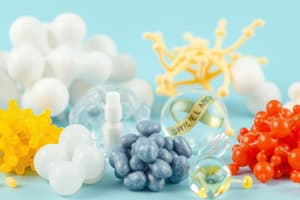Podcast
Questions and Answers
Which of the following polymers is derived from both natural sources and laboratory modification?
Which of the following polymers is derived from both natural sources and laboratory modification?
- Organic Polymer
- Natural Polymer
- Semi-synthetic Polymer (correct)
- Synthetic Polymer
A researcher discovers a new material produced by a deep-sea organism. After analysis, it is classified as a polymer. Which classification would this polymer most likely fall under?
A researcher discovers a new material produced by a deep-sea organism. After analysis, it is classified as a polymer. Which classification would this polymer most likely fall under?
- Semi-synthetic Polymer
- Synthetic Polymer
- Natural Polymer (correct)
- Modified Polymer
In a research lab, scientists are creating polymers from petroleum byproducts. Which type of polymer are they synthesizing?
In a research lab, scientists are creating polymers from petroleum byproducts. Which type of polymer are they synthesizing?
- Synthetic Polymer (correct)
- Organic Polymer
- Semi-synthetic Polymer
- Natural Polymer
A textile company is looking for sustainable materials. Which of the following would be considered a naturally derived polymer?
A textile company is looking for sustainable materials. Which of the following would be considered a naturally derived polymer?
A conservationist is trying to preserve a historical artifact made of a polymer material. The material is deteriorating due to environmental factors. To best preserve the artifact, knowing it's a natural polymer, what should the conservationist focus on controlling?
A conservationist is trying to preserve a historical artifact made of a polymer material. The material is deteriorating due to environmental factors. To best preserve the artifact, knowing it's a natural polymer, what should the conservationist focus on controlling?
Which statement best describes the relationship between monomers and polymers?
Which statement best describes the relationship between monomers and polymers?
If a polymer is described as 'poly,' what does this prefix most likely indicate about its structure?
If a polymer is described as 'poly,' what does this prefix most likely indicate about its structure?
Which of the following best clarifies what the term 'mer' signifies in the context of the word 'polymer'?
Which of the following best clarifies what the term 'mer' signifies in the context of the word 'polymer'?
A scientist discovers a new molecule made of 50 identical smaller molecules bonded together. Based on the information, how would this new molecule be classified?
A scientist discovers a new molecule made of 50 identical smaller molecules bonded together. Based on the information, how would this new molecule be classified?
Which characteristic is fundamental to defining whether a molecule is a polymer?
Which characteristic is fundamental to defining whether a molecule is a polymer?
Flashcards
What is a monomer?
What is a monomer?
A small molecule that, when repeated, forms a polymer.
What is a polymer?
What is a polymer?
A large molecule (macromolecule) composed of many repeated subunits (monomers).
What are 'mers'?
What are 'mers'?
The components that make up a polymer chain.
Polymer's Structure
Polymer's Structure
A molecule consisting of long chains formed by linked small molecules.
Signup and view all the flashcards
Polymerization
Polymerization
The process where small molecules (monomers) join to create large molecules (polymers).
Signup and view all the flashcards
What are Polymers?
What are Polymers?
Large molecules composed of repeating structural units (monomers).
Signup and view all the flashcards
What are Natural Polymers?
What are Natural Polymers?
Polymers found in plants and animals.
Signup and view all the flashcards
What are Semi-synthetic Polymers?
What are Semi-synthetic Polymers?
Polymers derived or extracted from natural polymers, and then modified chemically.
Signup and view all the flashcards
What are Synthetic Polymers?
What are Synthetic Polymers?
Polymers that are entirely man-made from small molecules.
Signup and view all the flashcards
Where Do Natural Polymers Come From?
Where Do Natural Polymers Come From?
Occur naturally and are found in plants and animals.
Signup and view all the flashcardsStudy Notes
- Polymers are presented by GROUP 2.
- "Poly" means many.
- "Mer" means parts or units.
- A polymer is a long chain molecule that is formed from small molecules linked together, with the small units called monomers.
Classification
- There are three classifications of Polymers.
- Natural Polymers
- Semi-synthetic Polymers
- Synthetic Polymers
Natural Polymers
- Natural polymers occur naturally and are found in plants and animals.
- Starch, proteins or polypeptides, and cellulose are some examples.
Semi-synthetic Polymers
- Semi-synthetic polymers are derived from naturally occurring polymers and undergo further chemical modification.
- Cellulose nitrate and cellulose acetate are some examples.
Synthetic Polymers
- Synthetic polymers are human-made.
- Plastic is the most common and widely used synthetic polymer
- Polyethylene, polyvinyl chloride (PVC), polypropylene, epoxy resin, rubber, polyester, and nylon are some examples.
Properties of Polymers
- Polymers have Physical, Mechanical and Thermal properties.
Physical Properties of Polymers
- Physical properties describes the appearance and behavior of polymers in relation to their environment.
- Density
- Solubility
- Transparency
- Color
Mechanical Properties of Polymers
- Mechanical properties describes the behavior of polymers under stress or load.
- Strength
- Stiffness
- Toughness
- Elasticity
- Plasticity
Thermal Properties of Polymers
- Thermal properties describes the behavior of polymers in relation to heat.
- Melting Points
- Glass Transition Temperature
- Thermal conductivity
- Thermal expansions
Summary
- Polymers are macromolecules formed by the combination of many small units called monomers.
- Polymers can be classified as Natural Polymers, Semi-synthetic Polymers, and Synthetic Polymers.
- Properties of polymers can be divided into three main types: Physical Properties, Mechanical Properties and Thermal Properties.
Studying That Suits You
Use AI to generate personalized quizzes and flashcards to suit your learning preferences.




